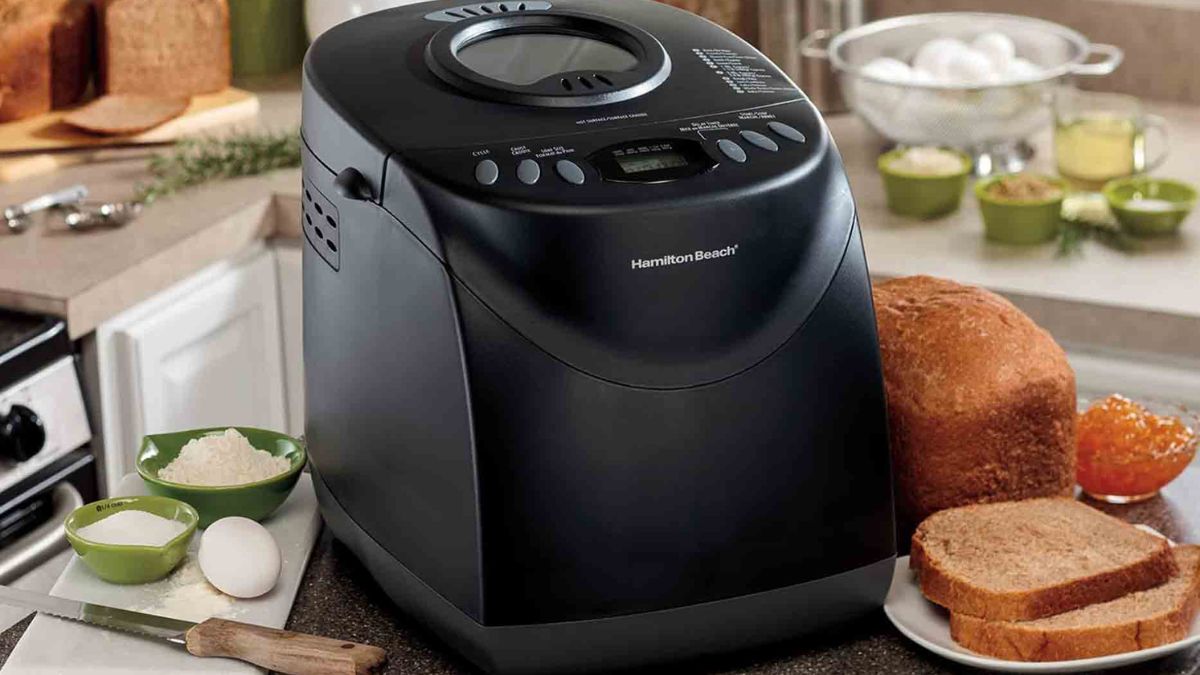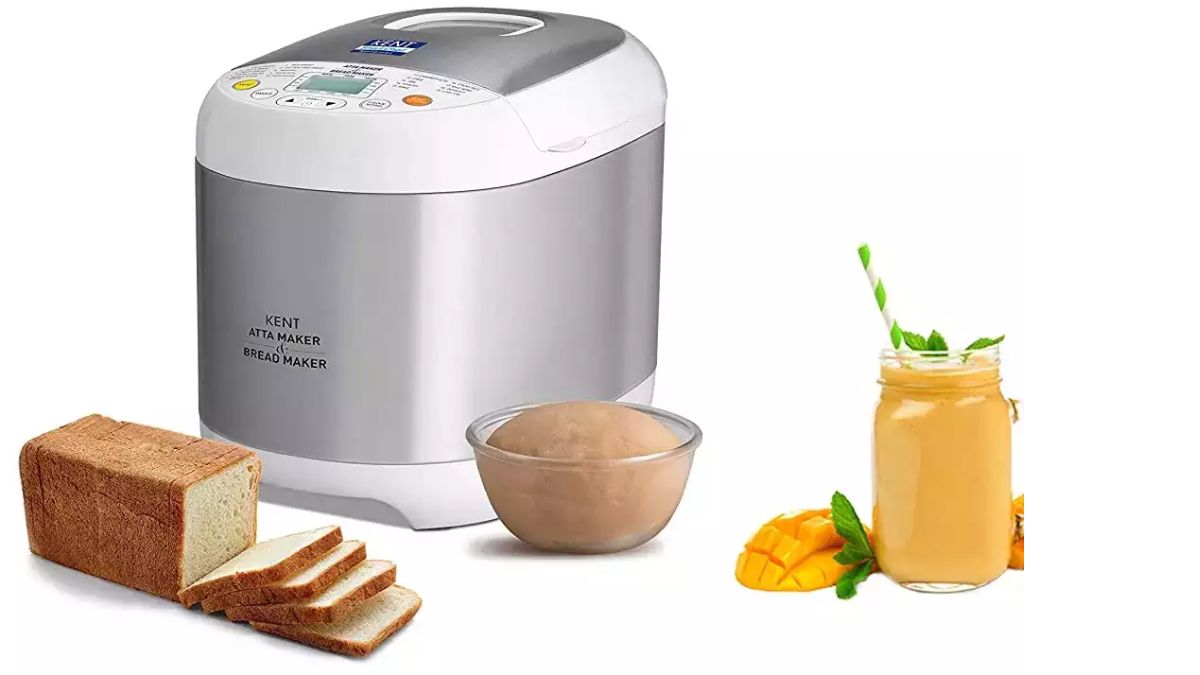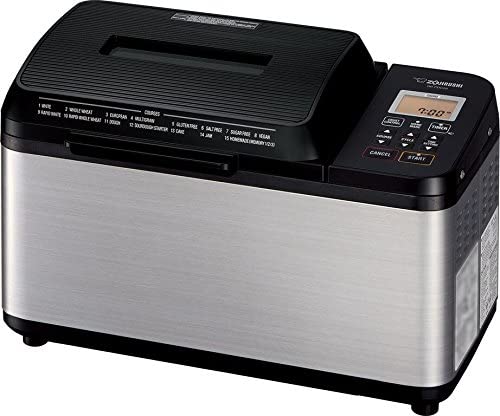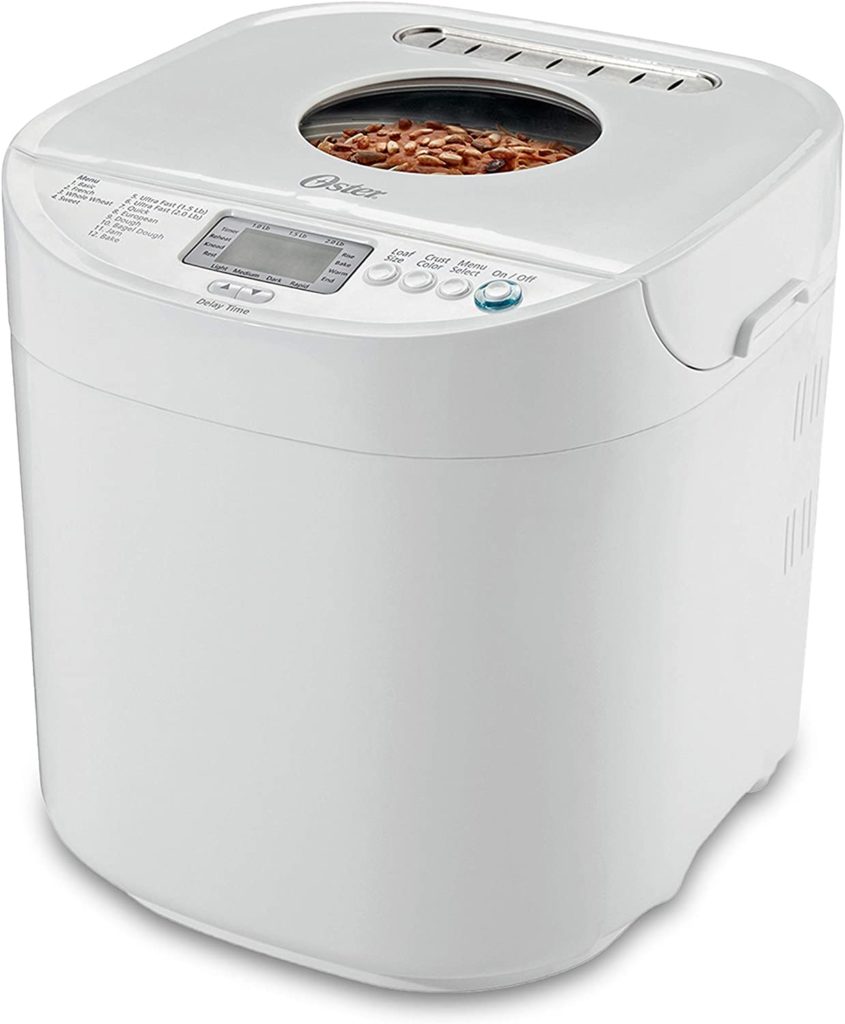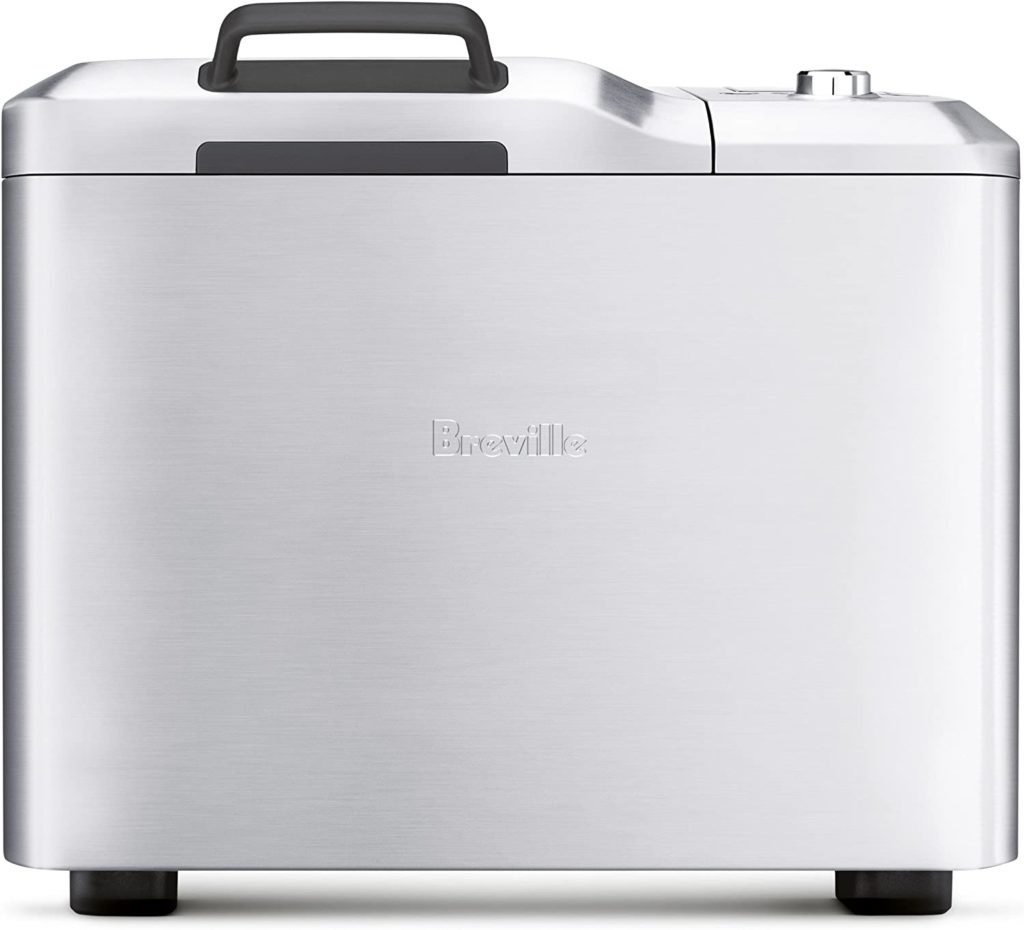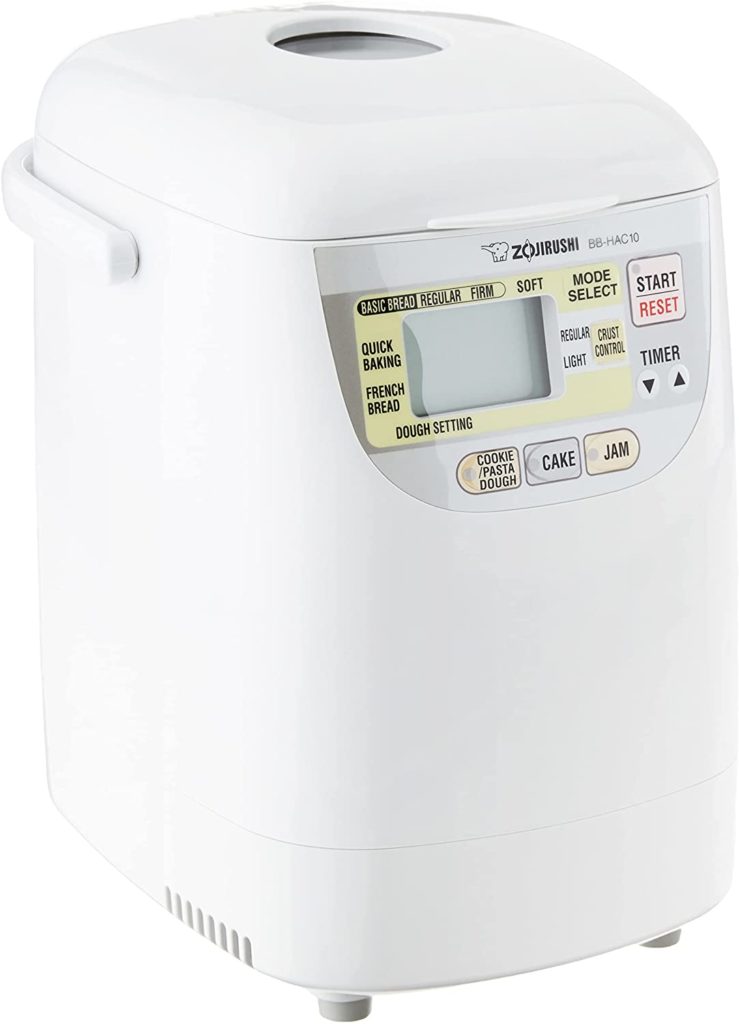If you want to get the most use out of your bread machine, you should use it to make bread. More specifically, you should make bread that fits in the tin of your particular bread machine. Pillow-soft bread typically turns out better in bread machines, and whole loaves are what you’ll want to prepare if you want to complete the entire process in your maker. Rolls, pizza dough, and pretzels can all be made in bread machines.
The Best Bread Machines
Here are the best bread machines:
1. Best Overall: Zojirushi Home Bakery Virtuoso Plus Breadmaker
What we Like
- Nearly flawless results
- Heated top for even browning
- Both fixed and customizable settings
What we don’t Like
- Expensive
- It takes up a lot of counter space
This Zojirushi bread maker has many features that will be useful to anyone who bakes a lot of bread at home and takes it seriously. Its lab and home tests performance made it our best overall pick. This model makes rectangular loaves that weigh 2 pounds and has a lot of custom settings so you can bake different kinds of bread exactly how you want.
You can choose a light, medium, or dark crust, and there are settings for primary and quick white or whole wheat bread, gluten-free bread, sourdough starter, jam, cake, and your recipes. This machine has two kneading paddles and a 13-hour delay timer to ensure that all the flour is mixed into the dough. A big window lets you see how your bread is doing as it bakes.
Dimensions: 18 x 10.5 x 12.875 inches | Weight: 24 pounds | Loaf Size: 2 pounds | Timer: 13-hour delay | Fastest Bake: 2 hours, 25 minutes | Electrical Rating: 700 watts
2. Best Budget: Oster ExpressBake 2-Pound Bread Maker
What we Like
- Even distribution of mix-ins
- A small footprint saves counter space
- Reliable recipes
What we don’t Like
- No gluten-free setting
- The display isn’t backlit
If you like the idea of fresh, easy-to-make bread but don’t want to spend a lot of money, this bread machine is a good choice. It has a reasonable price and a lot of features. The Oster Bread Maker has eight bread settings and three settings for the crust. It can make loaves that are up to 2 pounds. You can also use it to make jam at home.
Like most bread machines, this one has a delay timer that lets you add ingredients and bake them later. It also has a “keep warm” setting. If you are in a hurry, you can use the Expressbake feature to make a loaf in less than an hour. The results of our lab tests were the same. Some tests showed that the Oster did well, but not all of them. Where it did well, it beat other budget picks because the mix-ins were spread out evenly, the bread was springy, and it had an excellent taste. The top of the machine can be taken off, which makes it easier to clean. The basket was easy to clean, but the paddle was a little more complicated.
Dimensions: 12 x 11 x 11 inches | Weight: 8 pounds | Loaf Size: 2 pounds | Timer: 13-hour delay | Fastest Bake: 1 hour | Electrical Rating: 1,450 watts
3. Best Features: Breville Custom Loaf Bread Maker
What we like
- Intuitive controls
- Collapsible kneading paddle
- Gluten-free and yeast-free options
What we don’t Like
- Kneading paddle can be tricky to clean
- Can be loud
The Breville Custom Loaf Bread Maker will take your home cooking skills to the next level. It has automatic and custom programs, a pause button so you can reshape the dough or add a glaze, and it can store up to nine personal recipes. It has options for a gluten-free, yeast-free, crusty loaf, dough/pasta, jam, and loaves that weigh up to 2.5 pounds.
This bread machine has many features that make everything easy and easy to change. There is a window that lets you see how your bread is doing, a 13-hour timer that you can set, an automatic fruit and nut dispenser, an intelligent LCD screen, and 60 minutes of backup power (should your power go out). It also has a kneading blade that can be folded down, letting you mix the ingredients and then fold it down before baking.
4. Best Mini Baker: Zojirushi Home Bakery Mini Breadmaker
What we like
- Makes delicious bread
- Easy to use—no mixing required
- Compact design takes up little space
What we don’t Like
- It doesn’t have a gluten-free setting.
- The kneading blade gets stuck in the bread.
This slim bread maker is great for singles, couples, or small families who don’t want big loaves of bread. It fits in small spaces and makes a 1-pound loaf, but it still has the features you want in a good machine. It has a window to see the loaf, an easy-to-read LCD control panel, and a programmable timer that lets you put off baking for up to 13 hours.
Menu settings include basic (regular or firm) bread, soft bread, French bread, bread dough, cookie/pasta dough, cake, jam, and quick baking. The crust can be either regular or light, and a loaf of bread can be made in less than two hours with a short baking setting. Our tester loved how easy it was to use this machine and how good the food came out.
Dimensions: 8.5 x 11.25 x 12.25 inches | Weight: 12 pounds | Loaf Size: 1 pound | Timer: 13-hour delay | Fastest Bake: 2 hours | Electrical Rating: 450 watts
5. Best Compact: Cuisinart Compact Automatic Bread Maker
What we like
- Even browning and good aeration
- Easy to use and clean
- Keep warm setting
What we don’t Like
- I can’t always handle a 2-pound loaf.
The Cuisinart Compact Automatic Bread Maker is not relatively as small as a mini bread machine, but it is still perfect for kitchens with limited counter space. It has everything you need to make homemade bread in a smaller, space-saving design. The stainless steel design is 10.25 inches wide, 13.25 inches tall, and 11.25 inches deep. It weighs just over 10 pounds, so it’s not too hard to move it off the counter and store it elsewhere.
The Cuisinart Compact can bake up to 2-pound loaves and has 12 already set up options. The crust can be light, medium, or dark. There are gluten-free items, handmade jams, sauces, cake, and more on the menu.
There was a lot to like about this bread machine in the Lab. First, it was straightforward to use. The control panel was clear and easy to understand. The bread was evenly browned and had a good amount of air pockets. But you will have to be careful with recipes. During some tests, this machine couldn’t handle a whole 2-pound loaf, so we had to cut back on the amount of dough.
We did find the nonstick kneading pan that was easy to take off and clean. It has a 13-hour delay start like many other machines. When your loaf is done, there is also a setting to keep it warm, which isn’t common in bread machines.
Dimensions: 10.25 x 13.25 x 11.25 inches | Weight: 10.75 pounds | Loaf Size: 1, 1.5, or 2 pounds | Timer: 13-hour delay | Fastest Bake: 1 hour, 53 minutes | Electrical Rating: 550 watts
What to Look for When Buying a Bread Machine?
Loaf Capacity
Think about how many people you want your freshly baked loaf to feed and how much bread you can eat before it goes stale. There are settings on many bread machines that let you make loaves of different sizes, but the largest loaf size varies from device to machine.
Most bread machines can make loaves that weigh between 1 and 2 pounds, but some can make family-sized loaves that weigh 2 1/2 pounds. In theory, you can add more or less flour and water to any bread machine to make a bigger or smaller loaf. However, if you try to bake a 2-pound loaf in a device meant for 1-pound loaves, it might be pale, underdone, or rise too high out of the pan. And if you bake a small batch loaf in a machine made for more enormous loaves, you might get a very short loaf with a dry texture and a dark, thick crust.
Remember that more enormous, heavier loaves of bread will need more power to bake. The power of most bread machines is between 500 and 1000 watts. If you want to bake dense bread or loaves with lots of add-ins like nuts, seeds, or dried fruit, you should look for a bread machine on the higher end of that range to make sure it can bake heavier loaves well.
Machine Size and Weight
Larger machines are harder to move around and store, but they usually have more bread-making options. Smaller machines are more accessible to keep out of sight when not in use, but they may have fewer settings and can’t make big loaves of bread.
Loaf Pan Shape
You can choose the shape and size of your loaf pan when you bake bread in the oven, or you can make free-form loaves by hand. Since there is only one loaf pan, all the bread you bake in a bread machine will have the same basic shape. Most bread machines make loaves that are either tall and vertical or long and narrow.
Kneading Paddles
Higher-end bread machines usually come with two kneading paddles, while cheaper ones typically come with just one. You should use more than one paddle for the best results when kneading.
If the kneading paddle(s) stay in place while the bread is baking, there will be a hole or two where the paddle was. Most people don’t mind that the finished product doesn’t look as good as it could because it’s so easy and convenient to eat freshly baked bread.
But if you want loaves without these holes, look for a bread machine with paddles that can fold up or be removed. After kneading, machines with removable paddles will beep so you can take the dough out, remove the paddles, and then put the dough back in the pan for the final rise and bake.
Pre-Programmed Settings
There are a lot of features on bread machines today, which can be fun to try out, but a device with too many features might be too hard to use for your needs. Would you like to try different kinds of bread,
Some machines have settings for sweet loaves, whole-grain bread, sourdough, French bread, pizza dough, and more. The most straightforward machines only have a few scenes. For each type of bread, each of these settings changes the kneading, rising, and baking times to make the best loaf possible.
Extra settings are helpful for people who want to try out different grains and bread styles, but if you’re going to make basic sandwich bread to replace store-bought bread, a simple bread machine will do.
Do Breadmaking Machines Save You Money?
I assume how much does it cost to prepare a loaf in this manner? There’s no way to know because it relies on the precise substances you use. However, with the cost of flour rising and bakeries increasing the price of their loaves, I bet that a machine like this would quickly pay for itself in a year or two while also providing you with reasonably good bread.
How Easy are Breadmakers to Use?
Programming a breadmaker is a simple operation:
- Choose the bread variety (essential, whole wheat, multigrain, French, or pizza).
- Choose the baking setting (bake, bake rapid, sandwich, dough). By doing this, the order of mixing, kneading, rising, and baking is changed. For instance, when the machine is in dough mode, it pauses without really cooking the dough. At this point, you lift the top, take the dough out, and use it to make pizza, croissants, or whatever you like. Although you must bake those in your oven, the breadmaker makes the dough for you.
- Select the loaf size (large, medium, or small).
- Select the type of crust you want.
- Press the timer button. The display shows the total time the loaf will take to prepare and cook.
- Press the start button, and the countdown to a delicious loaf begins!
Conclusion
Perhaps you believe that bread-making machines are a relatively recent invention, having only been created in the previous 20 to 30 years? The one-loaf, home breadmaking machine was invented in 1986 by firms like Panasonic (a brand name of Matsushita Electric Industrial Co., Ltd. of Japan). It is true that small domestic breadmakers only gained popularity in the 1990s.
